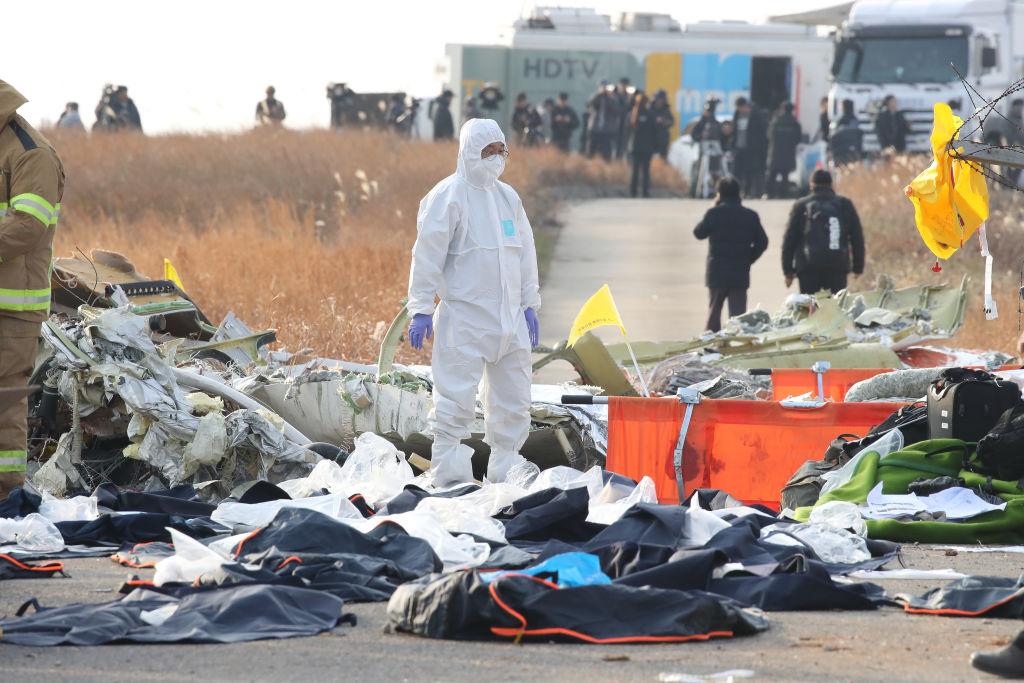On December 29, 2024, South Korea faced its deadliest aviation disaster in history when a plane crash claimed the lives of 179 people. The tragedy, which took place at approximately 9:00 AM KST (Korea Standard Time) near Muan International Airport, has left the nation and the global community in mourning. This devastating incident, which involved a Jeju Air Boeing 737-800, has sparked a wave of solidarity and grief from around the world. As investigators continue to probe the cause of the crash, the global aviation community is calling for unity and compassion in the face of this unimaginable tragedy.
The Tragic Details of the Crash
Flight 7C2216, a Boeing 737-800 operated by Jeju Air, was on a routine flight from Bangkok, Thailand, to Muan International Airport in South Korea. The aircraft was carrying a total of 181 people on board: 175 passengers and 6 crew members. Tragically, 179 people lost their lives in the accident, including 175 South Korean nationals and two Thai citizens. The two surviving crew members were able to escape the wreckage, but not without enduring the horror of witnessing their colleagues and passengers perish in the inferno that followed the crash.
The two survivors were rescued from the tail section of the aircraft, which detached from the fuselage during the impact. Despite the severity of the crash and the ensuing fireball, both crew members survived with non-life-threatening injuries. They were immediately transported to a nearby hospital and are currently reported to be in stable condition.
South Korea Faces Its Deadliest Aviation Disaster
This tragic crash marks the deadliest aviation accident in South Korean history. The country has experienced a number of aviation incidents in the past, but none on this scale. The loss of 179 lives has sent shockwaves through South Korea, leaving the nation in mourning and in search of answers.
The incident also carries global significance, as it highlights the ongoing challenges faced by the aviation industry. With air travel becoming increasingly common worldwide, the risks associated with aviation safety have never been more important. The crash serves as a stark reminder of the fragile nature of air travel and the need for constant vigilance and improvement in safety protocols.
A Global Call for Solidarity and Condolences
The impact of this tragedy has resonated far beyond South Korea's borders. In a time of such devastating loss, it is crucial that the global community comes together to support those affected. Governments and individuals around the world have expressed their heartfelt condolences to the victims' families, as well as to the people of South Korea.
The United Arab Emirates (UAE), in particular, expressed its deep sorrow over the incident, offering condolences to the families of the victims and to the government of South Korea. The UAE Ministry of Foreign Affairs issued a statement expressing solidarity with South Korea during this difficult time.
Global aviation bodies, such as the International Air Transport Association (IATA), have also offered their support, pledging to assist with the ongoing investigation and to work toward preventing future tragedies. As the investigation unfolds, there is a shared hope that lessons can be learned from this devastating event to improve air safety worldwide.
Cause of the Accident Remains Unknown
As of now, the cause of the crash remains undetermined, and investigators are still working to piece together the events leading up to the disaster. Multiple theories have been suggested, but none have been confirmed. South Korean aviation experts have indicated that it may take up to a year to fully investigate and determine the exact cause of the crash.
Among the possible factors being investigated is the possibility of a bird strike. Authorities revealed that air traffic controllers had warned the aircraft about the risk of bird strikes in the minutes before the crash. A surviving crew member reportedly mentioned a bird strike after being rescued, lending some credence to this theory.
However, bird strikes are not typically catastrophic on their own, and experts caution against jumping to conclusions. The aircraft's loss of landing gear, as seen in footage from the crash site, has also raised questions about potential mechanical failure. Further investigation is needed to determine whether a bird strike, mechanical malfunction, or a combination of factors led to the deadly incident.
Muan International Airport’s Bird Strike Record
The location of the crash, Muan International Airport, has raised concerns due to its history of bird strikes. According to data from the Korea Airports Corporation, Muan has recorded the highest rate of bird strikes among South Korea's 14 regional airports. In the years leading up to the crash, Muan recorded 10 bird strike incidents. While this number may seem small, it is notably higher than the rates at other major South Korean airports, such as Gimpo and Jeju.
Aviation experts have long warned about the risks of bird strikes, particularly at airports near coastal areas or fields, where migratory birds tend to congregate. Muan's location, surrounded by fields and near the coast, makes it particularly vulnerable to these incidents. In addition to the bird strike theory, investigators are also considering the possibility of a mechanical failure or human error.
Public Reactions and Social Media Outcry
As news of the crash spread, social media platforms were flooded with reactions from concerned netizens and aviation enthusiasts. Many expressed their condolences for the victims and their families, while others voiced skepticism over the reported cause of the crash.
Here are some of the reactions from Twitter users:
- @AviationSafetyPro: "Something doesn’t feel right about this crash. Bird strike theory seems too convenient. We need answers. #MuanCrash #JejuAir"
- @AirlineNews24: "Unbelievable loss of life. My thoughts are with the families of those lost in this tragedy. #JejuAirCrash #SouthKorea"
- @SkyWatchersUnited: "How did a plane slide down the runway without landing gear? This is not adding up. #AviationMystery #MuanCrash"
- @FlightWatchGlobal: "I’ve never heard of a plane losing its landing gear like this. Investigators need to dig deeper. #JejuAir #AviationSafety"
- @GlobalAirSafety: "Heartbreaking to see this tragedy unfold. I’m hoping for a swift investigation and answers for the victims’ families. #MuanCrash"
- @AeroExpert23: "Bird strikes are dangerous, but this doesn’t seem like a typical case. Something more may be at play here. #JejuAirCrash"
These reactions reflect the uncertainty surrounding the crash, with many demanding further investigation into the cause. While the bird strike theory is being taken seriously, aviation experts are not ruling out other possibilities, including mechanical failure or human error.
The Aftermath: The Long Road Ahead for Families and Investigators
In the wake of this tragedy, the families of the victims are left to cope with their unimaginable loss. For many, the grief is compounded by the uncertainty surrounding the cause of the crash. While the two surviving crew members are stable, the emotional toll on the families of the victims is immeasurable.
As the investigation continues, it is clear that there will be many more questions to answer. Aviation safety experts and officials from around the world are working together to ensure that the lessons learned from this tragedy are applied to improve safety standards and prevent similar incidents from occurring in the future.
For now, the world watches as South Korea navigates this painful chapter in its history, with hopes that the investigation will bring clarity to the cause of the crash and provide closure for the families who have been affected.



 Intel Rejects TSMC’s Allegations of Trade-Secret Leaks as Legal Battle Escalates
Intel Rejects TSMC’s Allegations of Trade-Secret Leaks as Legal Battle Escalates  Britain has almost 1 million young people not in work or education – here’s what evidence shows can change that
Britain has almost 1 million young people not in work or education – here’s what evidence shows can change that  Glastonbury is as popular than ever, but complaints about the lineup reveal its generational challenge
Glastonbury is as popular than ever, but complaints about the lineup reveal its generational challenge  What’s the difference between baking powder and baking soda? It’s subtle, but significant
What’s the difference between baking powder and baking soda? It’s subtle, but significant  Chicago Rejects New Federal Violence Prevention Grants After Policy Shift
Chicago Rejects New Federal Violence Prevention Grants After Policy Shift  Mexico Probes Miss Universe President Raul Rocha Over Alleged Criminal Links
Mexico Probes Miss Universe President Raul Rocha Over Alleged Criminal Links  Bolsonaro Detained Over Alleged Escape Risk After Ankle Monitor Tampering
Bolsonaro Detained Over Alleged Escape Risk After Ankle Monitor Tampering  Tunisian Opposition Figure Chaima Issa Arrested Amid Rising Crackdown
Tunisian Opposition Figure Chaima Issa Arrested Amid Rising Crackdown  UN General Assembly Demands Russia Return Ukrainian Children Amid Ongoing Conflict
UN General Assembly Demands Russia Return Ukrainian Children Amid Ongoing Conflict  Judge Dismisses Charges Against Comey and Letitia James After Ruling on Prosecutor’s Appointment
Judge Dismisses Charges Against Comey and Letitia James After Ruling on Prosecutor’s Appointment  Federal Judge Blocks Trump Administration’s Medicaid Funding Restrictions Targeting Planned Parenthood
Federal Judge Blocks Trump Administration’s Medicaid Funding Restrictions Targeting Planned Parenthood  Columbia Student Mahmoud Khalil Fights Arrest as Deportation Case Moves to New Jersey
Columbia Student Mahmoud Khalil Fights Arrest as Deportation Case Moves to New Jersey  The American mass exodus to Canada amid Trump 2.0 has yet to materialize
The American mass exodus to Canada amid Trump 2.0 has yet to materialize  Locked up then locked out: how NZ’s bank rules make life for ex-prisoners even harder
Locked up then locked out: how NZ’s bank rules make life for ex-prisoners even harder  Afghan Suspect in Deadly Shooting of National Guard Members Faces First-Degree Murder Charge
Afghan Suspect in Deadly Shooting of National Guard Members Faces First-Degree Murder Charge  Trump Vows Pardon for Former Honduran President as Honduras Faces Tight Election
Trump Vows Pardon for Former Honduran President as Honduras Faces Tight Election  Netanyahu Seeks Presidential Pardon Amid Ongoing Corruption Trial
Netanyahu Seeks Presidential Pardon Amid Ongoing Corruption Trial 



























